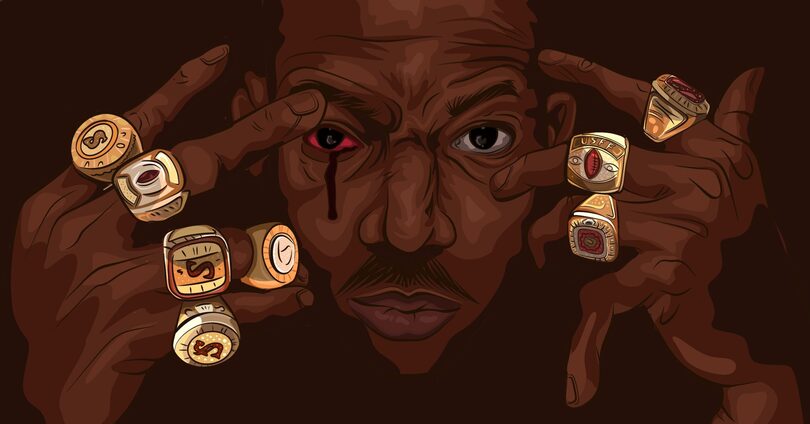‘HIM’ tackles brilliant critique on athletic pressure with stale writing

"HIM" follows quarterback Cameron Cade as he joins a football team and trains for a week under his hero, Isaiah White. However, things start to get scary when Cameron is forced to make a life-changing decision. Emma Soto | Contributing Illustrator
Get the latest Syracuse news delivered right to your inbox.
Subscribe to our newsletter here.
Expectation is the antithesis of satisfaction, a concept epitomized by Justin Tipping’s new horror thriller, “HIM.” The moment it was announced that Jordan Peele had a new film coming out, cinephiles were anxious with anticipation, wondering what the 21st-century master of fright would conjure up.
But, upon its release, the socially–charged thriller has been met with nothing but criticism, and in my opinion, this stems directly from its rollout.
By strategically attaching Peele’s name to every trailer and commercial promoting the film, “HIM” garnered substantial attention from the masses and quickly became a must-see movie for anyone familiar with Peele’s previous work.
While this was certainly a smart move from a marketing perspective, it was disappointing when people discovered that Peele didn’t direct this movie, but rather just produced it.
Remove Peele’s name from the picture entirely, and I think that people would be pleasantly surprised by this movie and the creativity behind it. Viewers should appreciate the artistry in the film rather than succumbing to any preconceived notions.
“HIM” follows rising star quarterback Cameron Cade (Tyriq Withers), the next great prospect in professional football. However, after a tragic accident, he can no longer participate in the United States Football Federation combine.
Cade has the opportunity to join the league and become the quarterback for his favorite team, The Saviours. But with one caveat: He must train for a week under his hero, the legendary Saviours QB Isaiah White (Marlon Wayans). Isaiah will decide if he has what it takes to play at the professional level.
As the training progresses, Isaiah’s methodology becomes increasingly unorthodox, each day being broken down into stages. It starts at obedience, and ends with sacrifice. Every day presents new challenges, slowly degrading Cameron into a state of pure psychosis.
The training forces Cameron to make a life-changing decision: quit at the precipice of greatness and lose everything, or endure the torment and transform into the superstar he was destined to be.
“HIM” is a creative exploration of the athletic psyche and the determination needed for someone to cement themselves as a legend. The movie is bolstered by a pair of wonderful lead performances from Wayans and Withers. Both of them miraculously overcome a deeply flawed script and institute a level of nuance into two characters who, if played by anyone else, would be very surface level.
Additionally, the premise of this film is intriguing. “HIM” is rich in symbolism, showcasing the exploitation of athletes and the sacrifices that must be made to reach their desired status. The movie delves into how Black athletes are sometimes seen as commodities at the hands of those around them, cyclically being taken advantage of by those higher up who hold the true power.
“HIM” attacks this notion, ending the movie with an epic final scene that sees Cameron refusing to bow his head to those in control to obtain a spot on the team. This refusal is a clear display of his power, and the power of all Black athletes who’re exploited by corrupt ownership in professional sports.
A lot of criticism for this movie comes from it being too on the nose in the message it’s trying to convey.
I couldn’t disagree with this point more. I think “HIM” does a tremendous job at blending subtlety with overt messaging and actually creates an incredible story about athletic excellence and the pressure athletes face from their environment.
No, this is not “Us” or “Get Out,” as it pertains to Peele. “HIM” is still drenched with enough “Peelisms” to leave the average fan satisfied. Tipping and company follow in the footsteps of the horror icon, using the same blend of horror tropes and visceral expression. It’ll leave you thinking about what different aspects of the film are supposed to represent.
“HIM” isn’t quite as grounded, nor as revolutionary as Peele’s movies, but it still serves as a respectable addition to the genre, and doesn’t deserve the critical bashing it’s fallen victim to.
While I do believe “HIM” is a much better movie than it’s being advertised as, it certainly isn’t without its faults. The dialogue can be incredibly stale at times, relying heavily on clichés that take you away from the story.
Also, the tertiary characters in this offer nothing to the overall film. Not only is the acting lackluster, but the writing is so poor that it almost ruins the entire viewing experience. This lack of refinement isn’t detrimental to how enjoyable the movie is, but it certainly negates the impact that specific elements of the film are supposed to evoke.
Often when movies like “HIM” are released, through a litany of early reviews, people quickly voice opinions that might not be entirely accurate. I went into this movie expecting to hate it, and left pleasantly surprised.
Despite the negative reaction this movie has received, after a couple of years, I think people will revisit “HIM” and discover that they might’ve been wrong about the quality of this film. I encourage anyone interested in seeing this to go into it open-minded, and you might come out just as surprised as I was.






